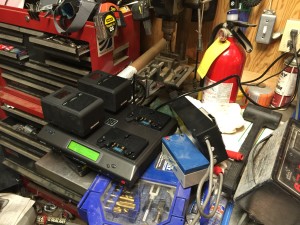I realized I haven’t done a gear blog in a while. I just wrapped up a shoot on the Iditarod Trail in Alaska and power was a big concern of mine. So I wanted to do a write-up about battery power.
At 515 Productions, we have lots of camera packages, but my go-to camera every time is the RED Epic Dragon. It is a beautiful piece of equipment that never ceases to amaze. The downside is it is a massive power hog. But I will get to that in a bit.
Having a background in news, IDX and Anton Bauer have been the industry standard in power solutions. But they have always been overpriced and tend to be finicky and underwhelming in their performance. After having four Anton Bauer Dionic batteries die on me, I decided to make a change and began the hunt for a new brand. I stumbled across Switronix, which had a similar size battery but much cheaper. Now, that is usually a bad sign, but I had already had a bunch of issues with other companies, so I decided to try them out. It has been the best choice by FAR. It is said that Lithium Ion batteries need to be cycled out of rotation every 3-4 years. We still have our original switronix batteries out in the field 5 years and counting, not a single hiccup. The batteries charge quickly, and hold that charge forever when not in use. A huge gripe I had with the AB batteries was that when not in use it is recommended that you always keep them on a charger since they discharge so quickly. That was just a pain when out in the field.
 The Switronix batteries come in a non-slip coating which, while not necessary, is very handy when wearing gloves. I have had my fair share of batteries dropped on the ground when passing hands, so the added insurance goes a long way.
The Switronix batteries come in a non-slip coating which, while not necessary, is very handy when wearing gloves. I have had my fair share of batteries dropped on the ground when passing hands, so the added insurance goes a long way.
Ours are all 3 Stud versions, but you can get them in V lock as well. Recent additions the past couple years have been USB ports put on the side so iphones, gopros, or any other accessory that utilizes USB can be powered off them. A big plus for me is the addition of D-Tap ports on the battery itself. Other companies rely on power plates to have the D-Tap. Having it on the battery itself means you can power LED lights, monitors, wireless transmitters, etc all wired direct to the battery, no more plates in between. It sounds like a small feature, but it comes in very handy!
 So, back to the Dragon. On a good day, this beast pulls 85w of power when its fully accessorized. That is a HUGE amount of power consumption. So in doing the math, a 90w battery would last just about an hour of record time. That means on a long day in the field you would either need to have a charger with you, or have about 10 batteries to make it through the day.
So, back to the Dragon. On a good day, this beast pulls 85w of power when its fully accessorized. That is a HUGE amount of power consumption. So in doing the math, a 90w battery would last just about an hour of record time. That means on a long day in the field you would either need to have a charger with you, or have about 10 batteries to make it through the day.
Welcome the new hottness: the 190w Hypercores. When we saw these we knew we had to have them. With a run time of about 2.5 hours on each battery (record time), we can get through an entire day on only 4 bricks. That saves a ton of space for all the other gear. This all came in very handy on my latest trip to Alaska to cover the Iditarod. Since the temps were dipping into the negative 50’s, the camera needed to stay on all day in order to keep itself in operating temps. So I would power it on as I went outside, put it in a bag and let it warm up. Then it would sit and wait for the action. The camera would stay on 10-12 hours a day, and I was only going through 4 batteries.
At the end of the day, I would throw them on my Digital quad position rapid charger and all the batteries would be ready to roll the next morning.
A real handy feature on the hypercores is the LCD readout on the back. It offers a fairly accurate read on power remaining. When on the charger, the readout actually tells you how long it will take to get fully charged, pretty slick. A fun game to play is putting the battery on less power-hungry items and watching the time remaining numbers skyrocket.
I can’t speak highly enough about this new lineup. Anything that can give me the ability to shoot all day in the remote wilderness of Alaska in -50 temps and never worry about power, that is something really invaluable.





